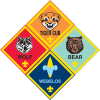 In this adventure you will explore the outdoor world of mammals, birds, plants, and more! You will understand that every living thing has a home. (Many are very near you.) You will also discover that almost every living thing’s neighborhood is a home to at least one type of another living thing. Protecting those homes, called habitats, is up to all of us, and you can help!
In this adventure you will explore the outdoor world of mammals, birds, plants, and more! You will understand that every living thing has a home. (Many are very near you.) You will also discover that almost every living thing’s neighborhood is a home to at least one type of another living thing. Protecting those homes, called habitats, is up to all of us, and you can help!
Rationale for Adventure
In this adventure, Bears will explore the outdoor world of mammals, birds, plants, and more! They will understand that every living thing has a home – often very close by. Scouts will also discover that almost every living thing’s neighborhood is a home to at least one type of another living thing. Protecting those homes, called habitats, is up to everyone, and Bears can help!
Requirements
Complete requirement 1 plus three others.
- While hiking or walking for one mile, identify six signs that any animals, birds, insects, reptiles, or plants are living near the place where you choose to hike or walk.
- Visit one of the following: zoo, wildlife refuge, nature center, aviary, game preserve, local conservation area, wildlife rescue group, or fish hatchery. Describe what you learned during your visit.
- Name one animal that has become extinct in the last 100 years and one animal that is currently endangered. Explain what caused their declines.
- Observe wildlife from a distance. Describe what you saw.
- Use a magnifying glass to examine plants more closely. Describe what you saw through the magnifying glass that you could not see without it.
- Learn about composting and how vegetable waste can be turned into fertilizer for plants.
- Plant a vegetable or herb garden.
Takeaways for Cub Scouts
- Learning about the world of creatures and how we affect our environment
- Practicing ways to conserve in the world around us
- A Scout is thrifty
Historical Requirements
2015 Handbook Requirements
Bear Handbook, page 70
Bear Den Leader Guide, page 63
- While hiking or walking for one mile, identify six signs that any animals, birds, insects, reptiles, or plants are living nearby the place where you choose to hike.
- Name one animal that has become extinct in the last 100 years. Tell why the animal became extinct. Name one animal that is on the endangered species list. Visit a government website to learn about endangered species in your area.
- Visit one of the following: zoo, wildlife refuge, nature center, aviary, game preserve, local conservation area, wildlife rescue group, or fish hatchery. Describe what you learned during your visit.
- Observe wildlife from a distance. Describe what you saw.
- Use a magnifying glass to examine plants more closely. Describe what you saw through the magnifying glass that you could not see without it.
- Learn about composting and how vegetable waste can be turned into fertilizer for plants.
- Plant a vegetable or herb garden.






